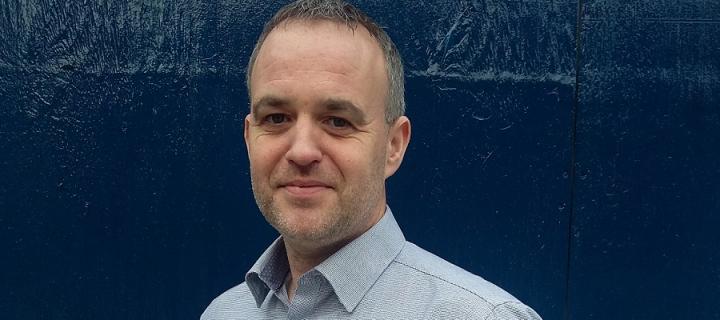Curating the history of Anatomy
Alumnus Malcolm MacCallum's role at the University involves working with the history of the University's study of Anatomy, and the hundreds of strange and marvellous objects that go with it.

My background
I studied Scottish Historical Studies at Edinburgh and had the good fortune to graduate just as the Museum of Scotland on Chambers Street was in development, so I got my first job as a curatorial assistant on that project, which was a brilliant experience for me.
Following the opening of the museum in 1998 I worked at National Museums Scotland (NMS) for several more years, learning to be a curator and helping to look after their 18th and 19th century Scottish collections, moving on to work with their collections of Scottish sport (a lot of curling stones!), before moving to the Museum of Flight at East Fortune to curate an exhibition for the soon-to-be-arriving Concorde. By this time, the plane (now an accessioned museum ‘object’) had been decommissioned and couldn’t fly up from London to East Fortune, so it was a huge logistical challenge for us all. It was great being part of the team that brought the plane north in what was a massive exercise that involved removing street furniture in London, commissioning a barge to carry the plane to Dunbar, closing the A1 and working with the army to install temporary track for the plane to get into the museum. I’m glad I moved on to working with much smaller objects of historical significance!
I think in my early years as a museum professional I was inspired by senior curatorial colleagues whose passion for their subject, attention to detail and amazing insight into the material culture of our past inspired me to learn more about my subject area. Following NMS I moved south to Preston to become Senior Curator of the National Football Museum (an interesting position for a Scottish football fan to be in) - this was a brilliant role for me and involved me curating a series of touring exhibitions across Asia, where I had to fend off far too many questions about whether I knew David Beckham!
I then headed back north to work at the Royal College of Surgeons of Edinburgh at Surgeons’ Hall Museum where I led a series of touring exhibitions as part of the Scotland & Medicine Partnership. Our first exhibition, ‘Anatomy Acts’, showcased some of the amazing medical collections in Scottish museums, and our second exhibition, ‘Human Race’, looked at the history of sports medicine, and we set up our displays in some unusual venues including the disused Govanhill Baths in Glasgow. By working with the subject of the history of medicine for the first time, I took great inspiration from the retired men and women, many of whom were notable surgeons, who came and volunteered for me and helped me research various subjects for the exhibition.
At Edinburgh
I am the curator of the Anatomical Museum and look after the 13,000 or so very important objects in our collection. The museum, which is based in the Old Medical School at Teviot Place and generally open on the last Saturday of the month, is really important as the objects basically tell the story of how medicine was taught at the University over 300 years. Crucially a lot of the specimens and models can be traced to the second half of the 18th century, when Scotland and Edinburgh in particular was playing a key role in the European Enlightenment and the quest to understand the workings of the body. There have been many notable students who have worked with the collections of the museum as part of their medical studies (James Young Simpson, Sophia Jex Blake, Arthur Conan Doyle and even Charles Darwin, although he only lasted about two years at Edinburgh before giving up his medical degree!) and I’m sure many of the students that are studying in the museum today will go on to be notable themselves!

I am in the fortunate position to be surrounded by many inspirational colleagues and students. As someone with a background in history, I’m continually in awe of the incredibly hard working medical students and anatomy staff and their amazing knowledge of anatomy and the intricate, important details of how our body develops over time, how it works and what happens when things start to go wrong. Many of my colleagues are conducting really important research into a variety of debilitating conditions with a view to improving the lives of people. I’m continually impressed by that.
My aims are to embed the museum collections in teaching (both medical and otherwise), increase our public engagement through events and open days, and to find out more about our amazing collection. We want to develop the museum, attract funding to conserve collections, improve interpretation, perhaps even in due course develop something like an audio guide for visitors.
Something I know...
A lot of people assume the Anatomical Museum collection consists of just anatomical models and human remains, and in the main that is true, but there’s actually a lot more to the collection than that. Our collection is nothing if not eclectic.
Where do I start? We have a skeleton of a three legged chicken, one of a two-headed dog, murder weapons from the 19th century, musical instruments made from parts of the human body, the original cast of the skull of both Robert Burns and Robert the Bruce, we have hundreds of poison arrows, about 300 death masks and life masks, we have a stuffed water rat that is said to cure baldness when eaten, and a skull which is believed to be that of Lord Darnley, the second husband of Mary Queen of Scots - although we are still investigating that one!
If you would like to visit the Anatomical Museum, the next public open days are:
- Saturday 30 March 2019
- Saturday 27 April 2019
- Saturday 25 May 2019

